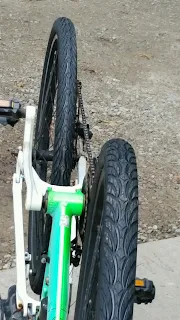Dads who spoil their daughters are so common that we are a cliche. Yes...I bought Bella a set of tires and installed them myself.
Just watch. She will make a big show of hating on me just to hide how awesomely impressed and thankful she is.
She is going to save a pile of money riding that bike around town!
Plums
Both Mrs ERJ and I have been enjoying European plums this season. I saved the pits and planted them in a vacant spot in the orchard.
I fully expect to buy a tree from a nursery for spring of 2020 but this gives me a back-up plan. Belt-suspenders with extra zip-ties squirreled away just in case that is not enough; that is how I roll.
Very few plums come true-to-type from seeds. Damson type plums might be the exception. I am sure that whatever comes up will be edible and I know how to graft so I am covered either way.
As a perishable fruit, plums are one of the types of fruit where it makes sense to have two or three varieties of different ripening seasons grafted onto one tree. The three varieties I am currently leaning toward are Blue Byrd, Senaca and President with Blue Byrd being the frame tree.
Anode rods
Shortly after installing the water softener, Mrs ERJ started observing that the hot water smelled like eggs.
 |
| This is what the top of the rod looked like. As you can see, it is getting eaten away. |
The factory anode rod was magnesium.
Anode rods function by jumping on the hand-grenade in terms of corrosion. When two different metals are electrically joined and in the presences of conductive water (pure water is not conductive) the form a battery. One metal is eaten up and the other is protected.
When only a single metal, like steel, is present then there is enough difference between the electrogalvanic potential of the grains and the grain boundaries for the steel to corrode all by its self.
 |
| I think the little, black bumps might be colonies of bacteria. |
It is hard to imagine bacteria thriving in a water heater but it happens. In our water heater, bacteria derived energy by stealing oxygen from sulfate cations and oxidizing magnesium. They defecated sulphide cations...the egg smell.
According to the great information superhighway, the answer is to use anode rods made from a zinc-aluminum alloy.
I replaced the rod and now have a dandy fire-starter, a 3' long by 3/4" diameter rod of magnesium.
The only question I have involves the plumber's tape I used on the thread. Anode rods need to be in electrical contact, that is metal-to-metal contact, to protect the water heater shell and the heating elements. I should probably throw a multi-meter on the top of the rod and the shell to see if I have continuity.

I had the same problem, I had to install an electric anode.
ReplyDelete